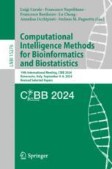Search
Search Results
-
Sequencing by binding rivals SMOR error-corrected sequencing by synthesis technology for accurate detection and quantification of minor (< 0.1%) subpopulation variants
BackgroundDetecting very minor (< 1%) subpopulations using next-generation sequencing is a critical need for multiple applications, including the...

-
Repeat and haplotype aware error correction in nanopore sequencing reads with DeChat
Error self-correction is crucial for analyzing long-read sequencing data, but existing methods often struggle with noisy data or are tailored to...

-
Error-corrected flow-based sequencing at whole-genome scale and its application to circulating cell-free DNA profiling
Differentiating sequencing errors from true variants is a central genomics challenge, calling for error suppression strategies that balance costs and...

-
Targeted accurate RNA consensus sequencing (tARC-seq) reveals mechanisms of replication error affecting SARS-CoV-2 divergence
RNA viruses, like SARS-CoV-2, depend on their RNA-dependent RNA polymerases (RdRp) for replication, which is error prone. Monitoring replication...

-
Virtual Sequencing of mtDNA
This project focuses on virtually sequencing mitochondrial DNA, utilizing a template isolated from Homo sapiens neanderthalensis. Initial sequences...
-
Sequencing accuracy and systematic errors of nanopore direct RNA sequencing
BackgroundDirect RNA sequencing (dRNA-seq) on the Oxford Nanopore Technologies (ONT) platforms can produce reads covering up to full-length gene...

-
DREAMS: deep read-level error model for sequencing data applied to low-frequency variant calling and circulating tumor DNA detection
Circulating tumor DNA detection using next-generation sequencing (NGS) data of plasma DNA is promising for cancer identification and...

-
Unveiling errors in soil microbial community sequencing: a case for reference soils and improved diagnostics for nanopore sequencing
The sequencing platform and workflow strongly influence microbial community analyses through potential errors at each step. Effective diagnostics and...

-
Utility analyses of AVITI sequencing chemistry
BackgroundDNA sequencing is a critical tool in modern biology. Over the last two decades, it has been revolutionized by the advent of massively...

-
The Evolution of Next-Generation Sequencing Technologies
The genetic information that dictates the structure and function of all life forms is encoded in the DNA. In 1953, Watson and Crick first presented...
-
CARE 2.0: reducing false-positive sequencing error corrections using machine learning
BackgroundNext-generation sequencing pipelines often perform error correction as a preprocessing step to obtain cleaned input data. State-of-the-art...

-
Next Generation Sequencing in Healthcare
With the fast development and broad application of next-generation sequencing (NGS) technology, data on genomic sequences is now reaching the aims of...
-
Cross Sequencing Integration of Compositional Microbiome Data in Cancer
High-throughput sequencing has revolutionized our understanding of the human microbiome, providing detailed insights into microbial communities under...
-
Digital RNA sequencing using unique molecular identifiers enables ultrasensitive RNA mutation analysis
Mutation analysis is typically performed at the DNA level since most technical approaches are developed for DNA analysis. However, some applications,...

-
Human B Cell Receptor Repertoire Sequencing
Next-generation sequencing has the potential to uncover the complex nature of B cell immunity by revealing the full complexity of B cell receptor...
-
DNA Sequencing Technologies and DNA Barcoding
DNA barcodes are short, standardized DNA segments that geneticists can use to identify all living taxa. On the other hand, DNA barcoding identifies...
-
NextDenovo: an efficient error correction and accurate assembly tool for noisy long reads
Long-read sequencing data, particularly those derived from the Oxford Nanopore sequencing platform, tend to exhibit high error rates. Here, we...

-
TDFPS-Designer: an efficient toolkit for barcode design and selection in nanopore sequencing
Oxford Nanopore Technologies (ONT) offers ultrahigh-throughput multi-sample sequencing but only provides barcode kits that enable up to 96-sample...

-
Application of Deep Sequencing in Phage Display
This chapter describes the workflow to implement deep sequencing into standard phage display experiments on protein libraries. By harvesting the...
-
Sequencing Trait-Associated Mutations (STAM) to Clone Rust Resistance Genes
Sequencing trait-associated mutations (STAM) is a simple and straightforward gene cloning method that was developed in wheat. It uses full-length...
